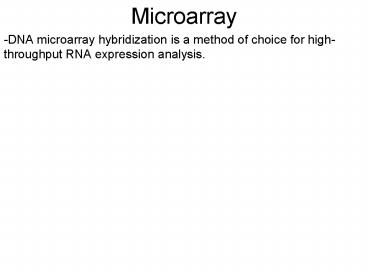Microarray - PowerPoint PPT Presentation
1 / 11
Title: Microarray
1
- Microarray
- -DNA microarray hybridization is a method of
choice for high-throughput RNA expression
analysis.
2
- -Its a high throughput technology.
- -In general array is an arrangment of points in
rows and columns. - A microarray is an extension of the concept
having a very small arrangement of many points in
rows and columns. - This technique basically originated from Southern
blotting and in this technique a series of high
density DNA spots bound to some solid support. - Microarray bind DNA to a solid base (usually a
glass), using robot automated processes (with
high precision). - The precloned immobilized DNA molecules can be
probed with labeled complementary sequences of
DNA.
3
- DNA microarrays have spots that contain known
sequences of DNA to which labeled sample of
unknown composition is hybridized and then
detected. - There are two major types of DNA array used in
expression analysis - 1. Spotted DNA arrays
- 2. Printed DNA arrays
4
- Spotted DNA arrays
- -A spotted DNA array is made by transfering
(spotting) actual DNA clones or PCR products
derived therefrom) individually onto a solid
support such as nitrocellulose membrane in a
precise grid pattern. - -Corresponding clones provide positive signal.
- -Comparative gene analysis requires the
preparation of duplicate arrays or the sequential
probing, stripping and re-probing of the same
array with two different probes. - -Nylon and glass microarrays are available.
- -Glass is an inert substrate and thus coated with
negatively charged phosphate groups of DNA are
exploited for immobilization on positively
charged surface groups provided. - eg. Poly-L-lysine and subsequently DNA
cross linked to the surface. - -Also, amino groups can be attached to DNA and
immobilized on aldehydes or epoxy-derivatized
surfaces.
5
- -In case of membrane, probe is usually labeled
with radioactive or enzymatic, which provide poor
signal. While fluorescent probes having higher
resolution, but becoz of autofluorescence of the
substrate in case of nylon membranes has a high
auto-fluorescence, generating low signal-to-noise
ratio. - -Interestingly, glass is a non-porous substance
having little auto fluorescence, fluorescent
probes can be used. - -Different fluorophores can be used to lable
different RNA populations. - eg. Two different probes Cy3 and Cy5 which
provide bright red and green fluorescence ,
respectively. - So, if a particular cDNA is present only in Cy3
labeled population the spot on the array is
green and red in case of Cy5, but if present in
both population contain equal proportion spot
will appear yellow.
6
- -In case of bacteria and also in Saccharomyces
cerevisiae, genomic array can be derived becoz
either lack of introns or few numbers only. - -Complete c-DNA sequence is not needed only the
signature sequences or ESTs are sufficient to
use. - EST (expressed sequence tags) By using high
throughput sequencing technology, thousand of
clones picked randomly from cDNA libraries and
subjected to single-pass sequencing to generate
2-300 bp cDNA signatures called expressed
sequence tags (EST).
7
- -Actually, the spotted arrays were having some
differences in the features (spots), and to
overcome this printed technologies were
developed. - -Spotting pins, piezoelectric devices similar to
inkjet printers and bubblejet printheads that
deposited DNA samples on the substrate as a
bubble extended from the nozzle.
8
- Oligonucleotide chips principle
- -Sequences are obtained from public or private
databases and synthesized on the chip. - -Each gene is reprinted by 20 non-overlapping
oligonucleotides each with a perfect match (PM)
and mismatch (MM) feature.
9
- Oligonucleotide chips are manufactured by in situ
oligonucleotide synthesis - -Affymetrix Inc. developed a light directed
printing technology known as photolithography. - -Glass or silicon wafer is hydroxylated and
silanized so that DNA can be covalently attached
to the surface in a simple chemical reaction. - -Covalent binding sites are blocked by a
photolabile protecting group. - A chromium mask is then applied to the surface of
the chip which determines which areas are exposed
to light. - Under illumination, the protecting groups in
these areas are destroyed. Allowing the addition
of a single nucleotide, which is also blocked
with a photo labile protecting group. - This method allows the production of most
accurate and densest arrays currently available
up to 64,000 features over an area slightly
larger than - 1 cm2 (GeneChip).
10
- -In contrast to DNA arrays, oligonucleotide chip
arrays are not double stranded clones or PCR
products, but single stranded targets ranging
from 25-70 nucleotides. - -Probes for chip hybridization are made from
cleaved, biotinylated cRNA (RNA that has been
transcribed in vitro from cDNA).
11
- Properties of different types of DNA array for
expression analysis - Property Spotted nylon
spotted glass Affymetrix - Target composition dsDNA (genomic, cDNA or PCR
products) ss-oligonucleotides - Target source derived from RNA, maintained
clones Seq derived
from -
public or private -
databases. Chemically -
synthesized - Target size 100-300bp
20-25nt - Array format Individual features
represent non-redundant clones Single clones
20 non -
overlapping oligos - Density 1-10
gt5000
64,000 to 10,00000 - Manufacture Robotized or manual
robotized On-chip
photolithographic - Substrate Nylon
Glass
Glass or silicon - Probe labelling Radioactive or enzymatic
Dual fluorescent Fluorescent - Hybridization High vol (50ml)
10 ul
200ul - 65 degree C
65 degree C 40
degree C - Data acquisition Autorad, phosphorimager
Confocal Confocal































